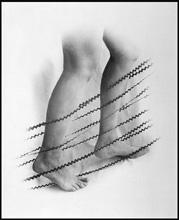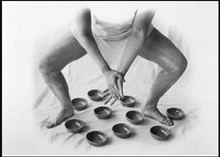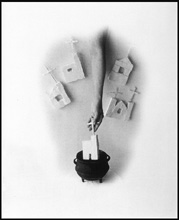
Department of Photographs of The J. Paul Getty Museum announces a symposiumThe Open Road: Photography In America 1850 - NOWThursday,
September 13 - Saturday, September 15th Thursday
September 13, 2001 Friday,
September 14, 2001 AFTERNOON
SESSION: AMERICAN PHOTOGRAPHY AND EARLY MODERNISM Saturday
September 15, 2001 AFTERNOON
SESSION: THE AMERICAN TRADITION TODAY Six Contemporary Artists, John Divola, Mark Klett, Catherine Opie, Stephen Shore, Catherine Wagner, Carrie mae Weems The American
Tradition & Walker Evans: Photographs from the Getty Collection For Reservations after June 30th: $75 for the
entire symposium Please note that registration is on a first-come, first-served basis; receipt of your check does not guarantee a reservation. Information:
JOYCE TENNESON AND WORLD'S LARGEST CAMERA HEADLINE 'ATLANTA CELEBRATES PHOTOGRAPHY'ATLANTA - The world's largest camera, a celebrity lecture series and photography exhibitions across the city will headline the third annual ATLANTA CELEBRATES PHOTOGRAPHY, a month-long festival of photography set for October 2001. This is the third annual city-wide celebration of photography planned by ATLANTA CELEBRATES PHOTOGRAPHY, a 501(c)(3) nonprofit arts organization. More than 75 fine art galleries, educational institutions and public spaces are expected to feature photography by local, regional and nationally known artists during the month. In addition, planners will bring to the city celebrity photographers Joyce Tenneson, Michael Kenna, Renee Cox and Pulitzer Prize winner John Kaplan as distinguished speakers, along with writer Michael Lesy. The Polaroid 20x24 camera - the world's largest camera at five-feet-high and 235 pounds - will be installed in Atlanta for one week. Reservations to use it to make 20"x24" original prints are available (tom@acpinfo.org). The larger-than-life instant camera, one of only five of its kind in the world, has gained acclaim for its impressive list of users, including artists Joyce Tenneson (haunting and mystical human figures), William Wegman (and his famous dogs), David Levinthal (and his Barbie dolls) and Timothy Greenfield-Sanders (celebrity portraits). A Portfolio Review Day is set for October 13, coupled with an October 13-14 Photo Trade Show, in collaboration with the Advertising Photographers of America. Also planned are a Juried Exhibition, Photography Studio Tours, an October 20 Celebration Party and Auction and a free comprehensive city-wide Event Guide. For more information, contact ATLANTA CELEBRATES PHOTOGRAPHY, a 501(c)(3) nonprofit art organization, at:
660-A 9th Street, NW Visit our website at www.acpinfo.org, or send email to corinne@acpinfo.org. SCHLESINGER LIBRARY'S EXHIBITION PROGRAMAs an institution committed to expanding public awareness of the roles of women in history and to advancing society by advancing women, the Schlesinger Library established an exhibition program which aims to:
With the exception of a few glass cases, the library's exhibition space consists of wall space available on the four floors of the building and totalling about 120 running feet. For this reason, the works exhibited should be mostly two-dimensional (photographs, prints, drawings, watercolors, paintings etc...). Exhibitors shall be responsible for the following:
The Schlesinger Library shall provide the following:
Viewing
hours for the exhibition shall correspond to regular Schlesinger Library
hours. If you are interested please contact Marie-Hˇl¸ne Gold at mhgold@radcliffe.edu
or 617.495.8647. For further information about the Schlesinger Library
please visit our website at http://www.radcliffe.edu/schles/
|
SCENE/SEENMarta
María Pérez Bravo
|
 |
 |
 |
With simple props that might be found in a kitchen or tool shed, Marta María Pérez Bravo conjures scenes that embody the sacred, giving prosaic form to mysteries of the spirit. Crossing boundaries between the sacred and the profane comes naturally for Perez Bravo, as her art and life are rooted in the tenets of a faith that finds the spiritual manifest in all things, natural and manufactured, living and inanimate.
A native of Havana, Pérez Bravo came to the Afro-Cuban religions
of Santería and Palo Monte as an adult, finding within them a way
of comprehending the world that was, for her, universal in its reach and
deeply personal in its touch. Her earliest photographs dealt with just
such a convergence: even as she became immersed in the religions of the
African Diaspora, she became a mother with the birth of twins. While Pérez
Bravo's infant daughters led her on a personal journey into maternity—with
all the attendant realities of diapers and conflicting feeding and sleeping
schedules—her photographs were immersed in Yoruba tradition, in which
twin spirits, called ibeji, are revered.
From
the moment she began to make art in 1986, Pérez Bravo has been
her own model in photographs shot by her husband Flavio, who operates
the camera according to the artist's direction. And from the earliest
photographs, made in the courtyard of their home in Havana's Marianao
section, Pérez Bravo has adhered to a singular format. Each photograph
depicts the artist enacting a concept derived from her faith, situated
within a white aura that causes the edges of the scene to vanish into
nothingness.
In
the pantheon of Santería and Palo Monte, white is associated with
Obatala, the spirit (or more properly, orisha) of creativity and purity.
With this white aura, Pérez Bravo honors Obatala and removes her
vignettes from their specific place—whether her home in Havana or
her current residence in Monterrey, Mexico—to a floating immaterial
space that is simultaneously familiar and visionary. In the process, Pérez
Bravo also transforms her body, so that she is at once an individual woman
and a representative of all flesh. In this, perhaps, she adheres to the
examples of Christian martyrdom inherited from Catholicism, her family's
religion and the furnace that forged the smelting of Africa, Taino and
European traditions in Cuba.
Like
many white Cubans who came to Santería and Palo Monte as adults,
Pérez Bravo regards folklorist Lydia Cabrera as a spiritual guide.
Fifty years ago, Cabrera was engaged in a decade-long study of the oral
histories and legends of Cubans of African descent, eventually publishing
her findings as El Monte in 1954. Like her peers, artist Wifredo Lam and
writer/musicologist Alejo Carpentier, Cabrera spent years in Europe that
led her to make connections between the modern fascination with African
art and the reality of African influence on Cuban culture.
Following
a generation of writers and artists whose work had been derived from academic
models, Lam, Carpentier and Cabrera were among a group of pioneers that
led Cubans to realize the uniqueness of the island's syncretic culture.
Lam has long been lionized as Cuba's foremost modernist, but Cabrera exerts
a special influence among many current artists. As Pérez Bravo
puts it, "Lydia Cabrera's books are like Bibles to me. I'm really
a devotee of her literature and thoughts." Cabrera's research remains
a great resource for understanding Afro-Cuban culture. But perhaps as
important for artists was her methodology: By attributing validity to
personal accounts and oral histories as cultural records, Cabrera encouraged
the next generation of artists and writers to value the subjective voice.
Subjectivity
is central to Pérez Bravo's photographs, which are composed with
an underlying symbolism alluding to her personal experience with spirituality.
The meanings of her images can be elusive, and clarity may not always
come from her titles, which tend toward the poetic and often incorporate
terms from Palo Monte. As Pérez Bravo works from her faith, certain
allusions may be clouded in translation to nonitiates. For such viewers,
the photographs may appeal purely in terms of their mystery and beauty.
But central themes and associations emerge for those who take a holistic
approach to Pérez Bravo's work, understanding that with each photograph,
the artist guides the viewer through her own spiritual journey. Indeed,
her recent photographs offer evidence that this journey is taken step
by step, and that each step is a profound encounter between flesh and
spirit, the commonplace and the holy, matter and the immaterial.
Several
recent photographs suggest a neophyte's searching need for faith. Posing
with her feet in mid-step, as if frozen in mid-journey, Pérez Bravo
describes the travails and comforts of a pilgrim's progress. "Cruzando
un Río" (Crossing a River) shows the artist's
bare feet among strands of elastic thread, in a shallow space defined
by a white sheet. Taken at its literal elements—feet, thread, sheet—the
scene is simple and mundane. But the title encourages us to think symbolically,
to imagine that the threads are ripples of water so that we see a woman
taking a cautious step through a shallow rivulet, moving slowly upstream.
Santería
and Palo Monte are religions of symbols, in which one thing invariably
stands for another. Having nudged her viewers toward symbolism, Pérez
Bravo sends us in search of metaphor and narrative. Is the woman fleeing
unseen pursuers, wading into water to throw the dogs off her scent? Or
is she moving with reverent care as she ascends toward some unseen vision?
Looking at Pérez Bravo's other scenarios, one begins to suspect
the latter. Recalling the sacred associations of rivers—cleansings,
baptisms, crossing over to Jordan—it becomes clear that the artist's
feet are leading us somewhere.
The
feet race across square stones marked with crucifixes in "Siete Cantos"
(Seven Songs), a path through the bedrock of music in religious rituals.
Ascending a stack of bricks in "Acosumbrado a Saltar" (Accustomed
to Jumping), the artist's feet act out an ecstatic faith in the miraculous
abilities of orishas, the divine spirits of ancestors. "The spirits
leap and fly without obstacles," Pérez Bravo says in reference
to this photograph.
"Buscando
un Secreto" (In Search for a Secret) shows the artist nearing the
source of her journey, posed as if diving headlong into a well. The well,
Pérez Bravo says, is filled with sacred inscriptions. As she surrenders
herself to the darkness of the well, the artist is figuratively reentering
the womb, preparing for rebirth in the rituals of her faith.
Pérez
Bravo demonstrates the routines of ritual with "Los Componentes"
(The Components), a series of three photographs showing the black kettle
associated with altars and ceremonies. Reaching from above, the artist's
arm deposits items into the kettle, each representing the various ingredients
that activate the sacred receptacle. Soil from a holy site is a powerful
activator, and its sources are indicted by small white carvings—graveyards
are represented by crucifixes, churchyards by church facades. Small bells
called aja, used to summon the orisha to ceremonies, are arranged in preparation
as one is delicately rung.
Obatala
is summoned by "Caballo" (Horse), in which the artist sits beneath
a white cloth topped by horsehairs. "Los Cantos Mandan" (The
Commanding Songs) shows the artist squatting over ten empty bowls, hands
clapping as she performs the songs that praise and direct the orisha.
The tools of ritual are infused with power, so much so that they become
extensions of the artist's body in Mbele, an Afro-Cuban term for knife.
The knife's handle is fused to her hand, so that the blade becomes an
appendage of her arm. The artist's hand is again transformed in "Ver
y Creer" (See and Believe), which uses her body to give physical
form to the orisha.
If
Pérez Bravo recalls the steps of her journey within Palo Monte,
from neophyte to initiate, there can be no doubt of her ultimate faith.
"Vive Ahi" (Live There) offers testament to a belief in miracles.
The artist is unseen, again posed under a white sheet. Atop her head is
a bowl holding a crescent moon. The image refers to a legend, Pérez
Bravo says. "It is said that if one places a plate of milk at night
as an offering to the moon, it takes a drink." In Spanish, the words
I translate as "it takes a drink" (ella baja a beber) also refer
to low tide, to the relationship of the moon and the oceans. In this still
and poetic image, Pérez Bravo finds an eternal cycle in the ephemeral
moment at which the moon's lips touch the bowl.
On
the thoroughly domestic stage on which she enacts her passion plays, Pérez
Bravo has found a kind of homespun transcendentalism. This is where her
photographs have the most power for those not initiated into her religion.
Although the references can be specific to Santería and Palo Monte,
Pérez Bravo speaks from a common vocabulary that connects her to
all faithful people. As she makes her journey, Pérez Bravo personal
cosmography speaks from the beliefs of one to the faith of many.
Grady T. Turner
Images
"Courtesy of Iturralde Gallery"
Teresa Iturralde
116 S. La Brea Avenue
Los Angeles, CA 90036
(323) 937-4267 Fsx (323) 937-4269
http://artscenecal.com/Iturralde.html
April 15–July 1, 2001 (see continuing schedule below)
LACMA exhibits revealing work by three generations of Cuban photographers
that highlights the continuing and extraordinary achievements of Cuba's
artistic community, as well as the social and political changes in Castro's
Cuba. Shifting Tides: Cuban Photography after the Revolution,
organized in three sections with a prologue gallery, includes more than
100 poignant black-and-white and color photographs. The exhibition is
on view April 15 through July 1, 2001, Los Angeles County Museum of Aet
Alberto
Díaz Gutiérrez (Korda)
Osvaldo Salas
Enrique de la Uz,
Ivan Cañas,
Rigoberto Romero,
María Eugenia Haya (Marucha),
José Alberto Figueroa,
Rogelio López Marín(Gory),
Juan Carlos Alóm,
Marta María Pérez Bravo, (only female photographer)
José Manuel Fors
Pedro Abascal,
Manuel Piña,
Carlos Garaicoa,
Abigail González,
Ernesto Leal
LACMA
exhibits revealing work by three generations of Cuban photographers that
highlights the continuing and extraordinary achievements of Cuba's artistic
community, as well as the social and political changes in Castro's Cuba.Shifting
Tides: Cuban Photography after the Revolution, organized in three
sections with a prologue gallery, includes more than 100 poignant black-and-white
and color photographs. The exhibition is on view April 15 through July
1, 2001.
Photography
in the Cuba of Fidel Castro has been and remains a thriving means of artistic
expression. Through their images, photographers working in the aftermath
of the military revolution have compiled a legacy of a people, of a country,
and of the revolution itself. From the epic pictures of the new social
order that followed the revolution through the experimental reclamations
of personal histories that defined a new generation, to the intensely
individualized spatial investigations of the most contemporary work of
artists using photography, Shifting Tides: Cuban Photography after
the Revolution provides insights into not only the evolution of
the photographic tradition of art making in Cuba but also the trajectory
and character of the revolution that spawned it.
Credit:
This exhibition was organized by the Los Angeles County Museum of Art
and was supported in part by the Andrew W. Mellon Curatorial Support Endowment
Fund. In-kind support for the exhibition is provided by KLON 88.1 FM.
Curator
Tim B. Wride, associate curator of Photography, LACMA.
Los
Angeles County Museum of Art
5905 Wilshire Boulevard
Los Angeles, CA 90036
323-857-6000 (general information)
323-857-0098 (TDD)
http://www.lacma.org
April 15–July 1, 2001
Venue
Dates Following LACMA:
Grey
Art Gallery, New York University
100 Washsington Square East
NY, NY 10003
(212) 998-6780
August 28, 2001 – October 27, 2001
Museum
of Contemporary Photography Chicago
600 S. Michigan Avenue
Chicago, ILL 60605
Jan 11, 2002 - March 9, 2002